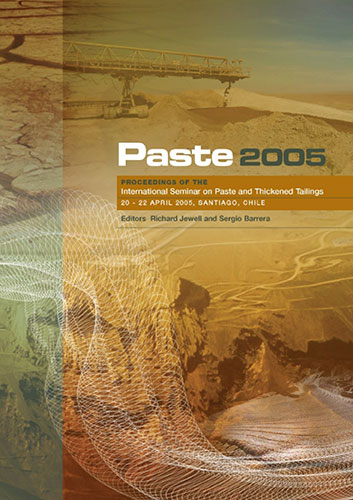High Concentration Tailings Transportation System Optimisation

|
Authors: Cooke, R |
DOI https://doi.org/10.36487/ACG_repo/563_12
Cite As:
Cooke, R 2005, 'High Concentration Tailings Transportation System Optimisation', in R Jewell & S Barrera (eds), Paste 2005: Proceedings of the International Seminar on Paste and Thickened Tailings, Australian Centre for Geomechanics, Perth, pp. 185-193, https://doi.org/10.36487/ACG_repo/563_12
Abstract:
The ever increasing move towards high concentration tailings disposal sys- tems over the last decade has mainly been driven by the need to achieve water savings. While the technology for implementing high concentration tailings sys- tems is largely mature, there is a tendency to design for systems for the maximum concentration tailings that can be produced. This often results in uneconomic system designs. This paper presents the findings of a study conducted to deter- mine the optimum concentration for a high concentration tailings transportation system. The study considers the effects of pipeline length, elevation change, ton- nage and energy cost. It is recognised that a comprehensive life cycle costing including all the tailings disposal elements must be performed before selecting the optimum tailings concentration. 186 Paste 2005, Santiago, Chile High Concentration Tailings... Cooke, R.
References:
Cooke, R. (2002) Laminar flow settling: The potential for unexpected problems,
Proc. 15th Int. Conf. on Hydrotransport, Bannf, Canada, 3-5 June.
Jewell, R.J., Fourie, A.B. and Lord, E.R. (Eds) (2002) Paste and Thickened Tail-
ings – A Guide. Published by the Australian Centre for Geomechanics, University
of Western Australia, UniPrint, 2002, 173 p.
Slatter, P.T. (1999) The role of rheology in the pipelining of mineral slurries, Min.
Pro. Ext. Met. Rev., Vol 20, pp. 281-300.
© Copyright 2025, Australian Centre for Geomechanics (ACG), The University of Western Australia. All rights reserved.
View copyright/legal information
Please direct any queries or error reports to repository-acg@uwa.edu.au
View copyright/legal information
Please direct any queries or error reports to repository-acg@uwa.edu.au